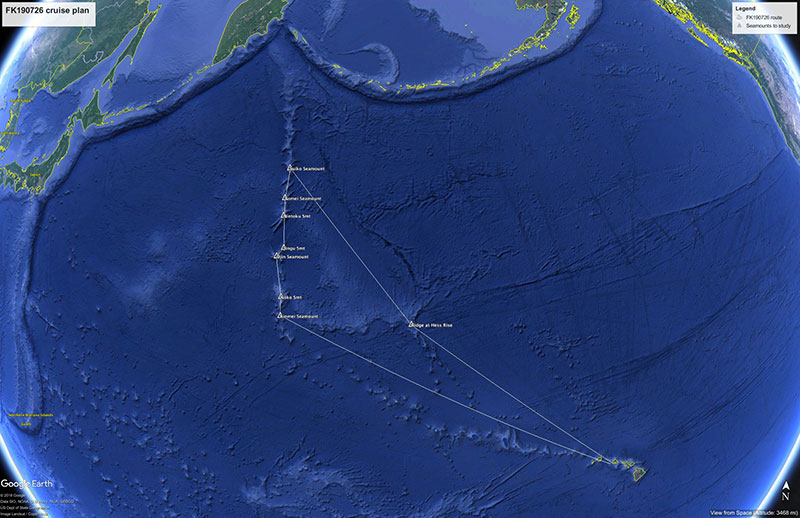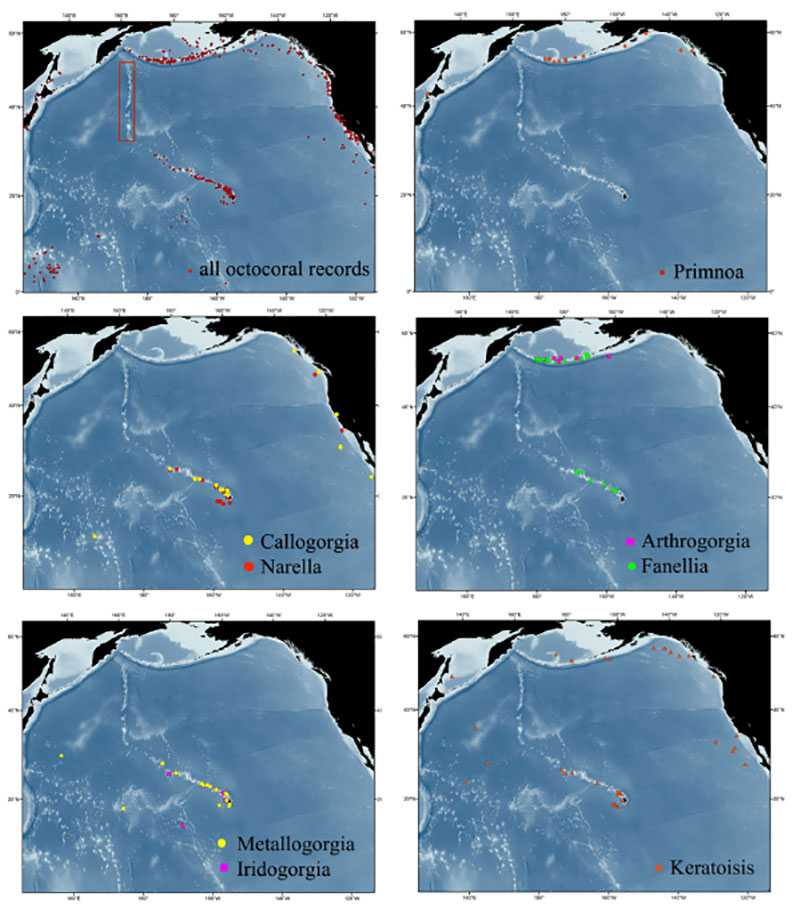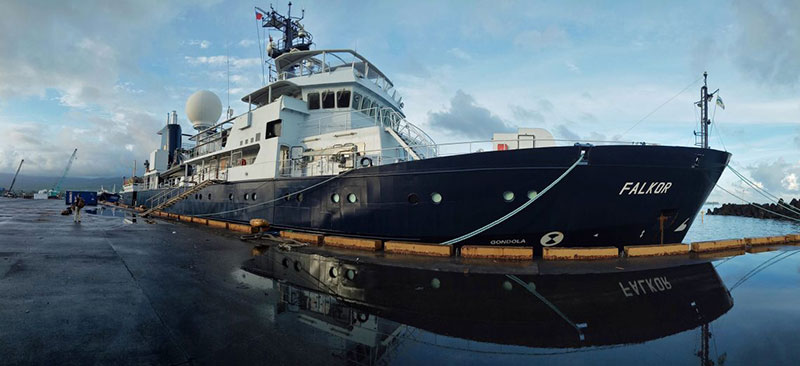
By Les Watling and John R. Smith, University of Hawaii at Mānoa
July 26 - August 26, 2019

Proposed route that R/V Falkor will take over the course of the expedition. Image courtesy of John Smith, University of Hawaii at Mānoa. Download larger version (jpg, 1.6 MB).
Animals have been used to determine distributional boundaries in shallow water since the mid-1800s. However, as one goes deeper into the sea, information about animal distributions becomes more and more scarce. In the northwest Pacific, there has been very little sampling at depths below that of the continental shelf (about 200 meters/656 feet), at least until comparatively recently. In 2004, a series of dives by the remotely operated vehicle (ROV) Jason II, provided by the Woods Hole Oceanographic Institution, were conducted along the Aleutian Ridge and in the Gulf of Alaska. Over a long series of years, the Hawaiian Undersea Research Laboratory (HURL) and the NOAA Office of Ocean Exploration conducted many dives along the Hawaiian Ridge and other areas in the Central Pacific through 2017.
Of all depths in the sea, the bathyal zone (800-3,500 meters/2,625-11,480 feet) is the least well known, yet contains much of the deep-sea diversity, including corals and sponges. In addition to the Aleutian Islands area and the seamounts from Hawaii to the Mariana Trench area, the bathyal fauna of the North Pacific has been mostly sampled off northern Japan. Even though much of the fauna has yet to be named and described, we know there is a significant difference in the fauna between the Aleutians and Hawaii, with the likely transition occurring somewhere along the Emperor Seamount chain. This is the only range of seamounts between these two areas that can harbor bathyal species.

Known octocoral records from the North Pacific, including along the Aleutian Islands, west coast of North America, and Hawaiian Ridge. Most records from Japan are outside the area of this map. Rectangle in upper left box indicates extent of the Emperor Seamounts. Image courtesy of John Smith, University of Hawaii at Mānoa. Download image (jpg, 131 KB).
Our hypothesis is that this faunal boundary is created by the east to west flow of North Pacific Intermediate Water that crosses the Emperor Seamount chain at the Main Gap – suspected on the basis of existing data to lie between Nintoku, Jingu, and/or Koko Seamounts. During this mission on the Schmidt Ocean Institute's R/V Falkor, we are seeking to study the benthic (seafloor) communities (focusing on octocorals and sponges) of two or three seamounts on each side of the Main Gap, using geochemical tracers (Ra-226, Ra-228, Cs-134, and Cs-137) as well as physical data such as temperature and salinity to determine the water masses bathing the seamounts. In addition, we will make measurements of current flow and direction from the surface through the bathyal depths.
Thus, the primary objective of this project is to explore and determine the nature, location, and extent of the biogeographic transition between the North Pacific and North Pacific Boreal bathyal provinces (as defined in Watling et al., 2013) and to understand the evolutionary history of this biogeographic pattern. Specific tasks to support this effort will include comparative taxonomic and evolutionary analyses on living octocoral taxa, and with the physical and chemical measurements, assess the influences of water mass movements on species distributions. We will also sample dead coral skeletons to determine the longer-term history of these conditions. Radiocarbon, total alkalinity, and nutrient analyses will be employed to identify and characterize the interaction between the different currents and water masses.

Circulation of North Pacific surface/intermediate waters (right) and upper deep waters (left) according to Kawabe and Fujio (2010). Right panel arrows east of Japan indicate flow of North Pacific Intermediate Water through the Emperor chain. Left panel shows counter flow of North Pacific Deep Water through the bottom of the same gap, called the Main Gap. Image courtesy of John Smith, University of Hawaii at Mānoa. Download image (jpg, 84 KB).
Using telepresence, video the dives conducted by the Schmidt Ocean Institute's ROV SuBastian will be available and streamed live to the public as well as to other scientists, including resource managers and scientific committee members in the North Pacific Fisheries Commission (NPFC) countries. The latter are responsible for managing fisheries both for fish and corals in the area of the Emperor Seamounts.
In the 1970s, more than 800,000 tonnes of fish were taken from the southern part of the Emperor Seamount chain, and over the years, an untold amount of deep-sea coral has also been removed from the sides of some of the seamounts. Recently, the NPFC has been taking responsibility for the management of biological resources along the Emperor Seamount chain. The loss of the corals from these areas might ultimately complicate the biogeographic analyses, and so some parts of expedition dives will be devoted to looking for evidence of coral fishery, as time allows.

The expedition will take place on the Schmidt Ocean Institute's R/V Falkor, shown here docked in Apia, Samoa. Image courtesy of Schmidt Ocean Institute. Download larger version (jpg, 300 KB).
The NOAA Office of Ocean Exploration and Research contributed funding for this expedition via its Federal Funding Opportunity for Ocean Exploration.